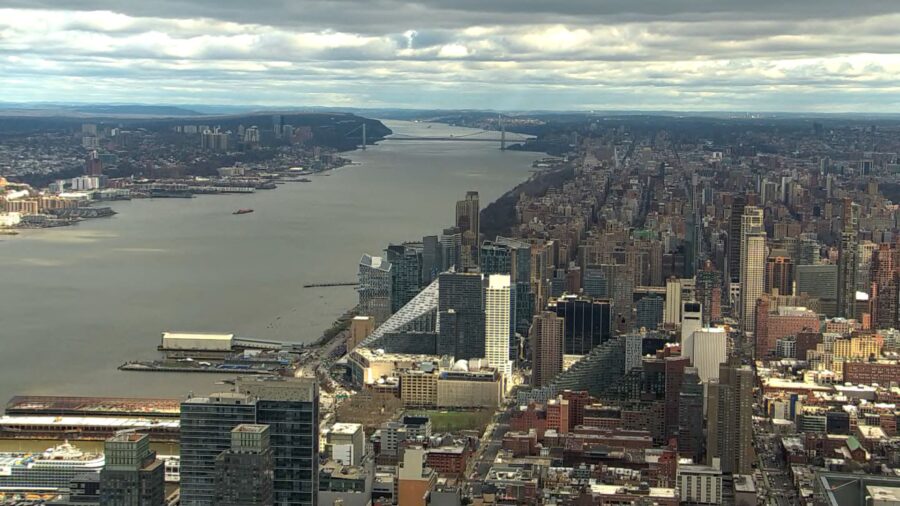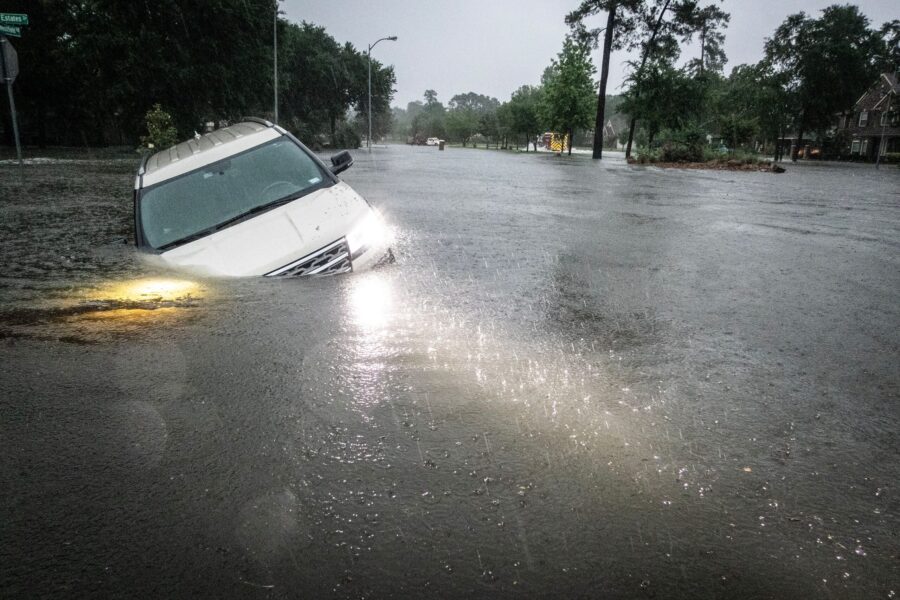Aftershocks rattle Northeast after rare 4.8 magnitude earthquake hits region
Apr 6, 2024, 6:59 PM

New York City residents felt an earthquake Friday morning. (CNN)
(CNN)
(CNN) — A 4.8 magnitude earthquake rattled buildings across parts of the Northeast Friday morning, according to the US Geological Survey, with tremors felt from Washington, D.C. to New York City to Maine.
It was the third largest earthquake recorded in the area in the last five decades and the strongest in New Jersey in more than 240 years, the USGS said. The rare quake was felt by millions of people across hundreds of miles, disrupting work and school life and jolting nerves momentarily before an early spring day seemed to return to normal.
In a region unaccustomed to earthquakes, stunned residents across large swaths of the Northeast described initially thinking of a passing tractor trailer or freight train before realizing it was something more. With authorities reporting little or no damage, and minimal travel disruptions, people soon resumed their everyday lives.
“At first I thought it was a big truck driving down a nearby road or the oil burner shaking inside my house,” said Jeanne Evola, who described her whole house shaking in Franklin Square on Long Island.
She ran outside as the quake intensified. She found her neighbors describing the same rattling, realizing they had experienced an earthquake in a suburb about 20 miles east of New York City.
The New York Police Department said there were no damages or injuries reported.
“New Yorkers should go about their normal day,” New York Mayor Eric Adams said at a news briefing later Friday.
The USGS recorded 28 aftershocks following Friday’s rare earthquake, with the largest aftershock – clocking in at a 3.8 magnitude – striking Gladstone, New Jersey, 20 minutes from the epicenter, at 5:30 p.m.
Seismologists refer to the largest earthquake event in an area as a mainshock. On Friday, the mainshock was recorded at 4.8 magnitude.
The rule of thumb
As a rule of thumb, scientists have seen the following pattern play out for aftershocks after the mainshock: One aftershock about 1 magnitude less, 10 aftershocks about 2 magnitudes less and 100 aftershocks about 3 magnitudes less.
“We can’t predict specifically how long aftershocks will last or when they will happen. They will happen for weeks or even months,” USGS geophysicist Paul Caruso told CNN on Saturday. “But as time goes on, they will be less frequent and lower magnitude.”
There is a 74% chance of magnitude 3 and above aftershocks happening within the next week, and just 1% chance of aftershocks magnitude 5 and stronger, the USGS estimates in its aftershock forecast.
USGS said the initial earthquake occurred at 10:23 a.m. The New York City Fire Department said the department received reports of shaking buildings about 10:30 a.m.
“We are responding to calls and evaluating structural stability,” the department said in a statement. “There are no major incidents at this time.”
In some parts of the New York City area, startled residents spilled out from tenements and row houses onto the sidewalks in front of their buildings in the minutes after the shaking stopped.
“Everything started vibrating then I felt the building shake,” said David Rodriguez, a resident of Hoboken, New Jersey. “I thought it was a large truck outside until everything started swaying. But it had that sound of something swaying from side to side.”
Reaction
The X account for the Empire State Building posted: “I AM FINE.”
Long after the quake subsided, residents were startled anew by loud emergency alerts on their mobile phones. At 11:46 a.m. came another alert, this one warning of potential aftershocks. Addressing the delay, a city emergency management official called an earthquake “a no notice event” and said authorities had to confirm the information they were receiving.
“New Yorkers are not accustomed to having earthquakes in our state,” New York Gov. Kathy Hochul told reporters. “Everyone should continue to take this seriously.”
NYC Department of Buildings Commissioner James Oddo asked for the “cooperation” of construction professionals for reports of damage to the city’s 1.1 million buildings.
In New Jersey’s Hunterdon County, where Lebanon Township is located, there were no reports of injuries or evacuations in the area around the epicenter, according to county officials.
The Board of County Commissioners said a damage assessment was underway and officials were beginning to receive reports of structural issues in buildings.
Three neighboring homes in Newark, New Jersey, were evacuated after residents reported structural damage, according to the city’s public safety director.
No injuries were reported but firefighters responded to calls about structural damage in the three buildings, more than 30 miles from where the quake originated, according to Newark Public Safety Director Fritz Fragé.
Ten families – 25 adults and three children – were relocated, he said.
All Newark city buildings were closed. Fragé said the city was inspecting buildings for damage and power outages.
In New Jersey’s Essex County, the quake is believed to have caused a water main break, according to the Office of Emergency Management of the Township of Montclair.
In Pennsylvania, the Philadelphia Police Department received more than 200 calls “in a very short period of 20 minutes” after the quake, Commissioner Kevin J. Bethel said. The calls overloaded the system.
“We were able to get our call base back down within 30 minutes,” Bethel said.
‘Good quality New York moment’
More than 23 million people felt “light shaking,” which is felt by most people and can cause cars to rock noticeably and cause a sensation like a truck striking a building, according to the USGS.
About 9,000 people felt “strong shaking,” which is described by the USGS as “felt by all” and can move heavy furniture and cause slight damage. This would occur closest to the epicenter near Lebanon, New Jersey. And nearly 300,000 people felt “moderate shaking,” which could be strong enough to break windows or cause dishes to fall.
Reed Whitmont, who lives in Park Slope, Brooklyn, was sitting in bed inside his old apartment building when everything started shaking. Then the cat bolted.
“It went on for about a minute, then I stuck my head out the window and all the neighbors were shouting and asking each other if they felt that too. Good quality New York moment.”
In Jersey City, New Jersey, Kristina Fiore was sitting at her desk in her apartment when her building shook for a few seconds.
In video from inside the home, objects rattled as a cat runs away. “It’s okay. It’s an earthquake!: Fiore is heard saying. At first Fiore thought there was an explosion at a nearby metal recycling plant, but the shaking got stronger. “I said out loud, ‘It’s an earthquake’ because I could tell that my 5-year-old was worried about what was happening. Also my cats were really freaking out. They were scared and confused for like an hour after the quake.”
At the Boonton Coffee Co. shop in Boonton, New Jersey, a video shared on social media showed customers running out of the store in confusion when the building started shaking. Some people are heard panicking. Others continued ordering with their barista.
The light shaking would be unlikely to cause damage, per initial data indications from the USGS. Initial reports indicated a 4.8 magnitude quake, but that was revised to 4.7 before being adjusted back to 4.8. This could change again as more data is reviewed.
The epicenter was just northeast of Lebanon, New Jersey, less than 50 miles west of New York City, according to the USGS.
The light quake was shallow, just below the surface at 5 km depth, which made it easier for residents in affected areas to feel the shaking. Initial reports indicate shaking was widely felt in New York City, Philadelphia and Washington, DC.
Some air and train travel affected
The USGS said a number of factors influenced the amount of places where the quake was felt, including the geology of the region itself.
The earthquake was on the extreme end of what the USGS considers a shallow earthquake: 0 to 70 km deep. The energy released by an earthquake is blunted by distance, so a shallower quake of the same magnitude as a deeper one will produce much more intense shaking at the surface.
The rocks that make up the Earth’s crust and mantle in the eastern US are much older, denser and harder – compressed by time – than they are in the West, according to the USGS. This makes them more efficient conduits of the seismic energy released by an earthquake, allowing it to travel in a more potent form over longer distances.
Buildings are also older in the Northeast and may not be designed to the latest earthquake code, the USGS said. This is particularly a concern for shorter buildings like houses. Earthquakes tend to shake in a faster back-and-forth motion in the East compared to the West, which puts smaller buildings more at risk for damage, the USGS noted.
The earthquake affected some air and train travel in the Northeast.
Flights to the New York Kennedy, Philadelphia, Baltimore, and Newark airports were initially held, according to the Federal Aviation Administration.
The air traffic control tower at Newark Liberty airport was being evacuated, a controller said in a radio transmission after the earthquake, meaning flights were being held while controllers moved to an alternate location.
”Nobody’s going to go anywhere for the time being,” a controller said over the radio frequency.
The runways were in the process of being inspected for damage.
At noon the FAA reported a ground stop remained in effect at Newark, and the controllers were relocating back to the tower.
Amtrak reported train service was slowed after the earthquake so track inspections could be performed.
“As of 3:30 PM ET, All inspections have been completed and service has been restored to normal speed. Residual delays should be expected,” Amtrak posted on X.













